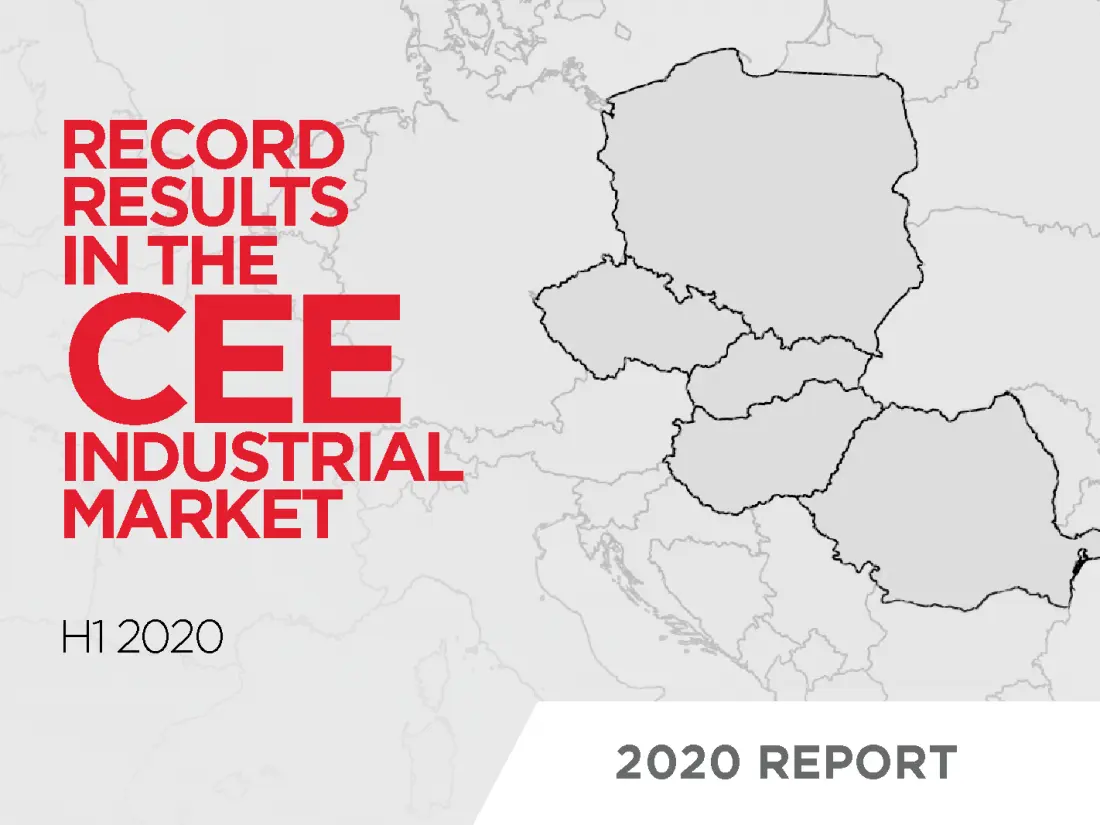Record results in the CEE industrial market in H1 2020
01 november 2020

Contents
- In H1 2020, leasing activity reached 50% and more of last year’s transaction volumes in all the CEE countries.
- With 1 million sq m of industrial space completed, Poland remains the largest industrial and logistics market in CEE.
- Concerning new development, Slovakia and Hungary reported more completed industrial projects in H1 2020 than in the whole of 2019, while the Czech Republic reported 68% of last year’s volume in H1 2020 already.
- In 2020, the region’s total warehouse stock is very likely to exceed 40 million sq m. The CEE market has doubled in just five years.
- The biggest investment transaction in CEE in H1 2020 was GLP’s acquisition of Goodman Group’s logistics portfolio, where Cushman & Wakefield represented the buyer.
“The rapid expansion of e-commerce and the unprecedented sales growth are driving logistics improvements and development of logistical models based on service outsourcing. By outsourcing fulfilment to specialized firms, retailers are able to improve delivery times and efficiency, offer customers various payment and delivery options and to bring down transportation costs, with shoppers increasingly favouring online shopping. We expect this market segment to grow in the future, especially in terms of quality improvement and increasing the flexibility of logistics services.
Moreover, we expect to relocate parts of warehousing and production processes from Asian and Western European countries as part of diversification and ensuring security of supply chains, which is bound to drive the growth of the industrial market in the CEE region forward - says Ferdinand Hlobil, Partner, Head of Industrial Agency CEE, Cushman & Wakefield.
Local market
Poland
- Net take-up at 1.68 million sq m – the highest leasing activity in the first six months of a year on record and up by approximately 42% on H1 2019.
- Healthy supply – over 1 million sq m of new warehouse space delivered in various facilities: multi-let parks, urban logistics projects and BTS schemes supporting logistics and production.
- Robust developer activity – still strong, but more muted than last year due to a slight decrease in speculative construction that was on a large scale before the COVID-19 pandemic struck.
- Stable rents – largely due to lower costs of general contractor services compared to last year. Upward pressure on rents will be caused in the long term by strong demand for urban logistics projects and the shrinking availability of lands for such projects.
- The growth of e-commerce and further transport infrastructure improvements coupled with Poland’s strategic geographic position in Europe are the key drivers of the strong interest in the Polish industrial market, also from investment funds.
The Polish warehouse market remains one of the fastest growing in Europe. Both tenant and developer activity remained robust in H1 2020 as evidenced by strong take-up totalling almost 2.3 million sq m (+26% y/y) and a significant amount of new supply exceeding 1 million sq m delivered since January 2020. Five core regions dominate the market: Warsaw, Upper Silesia, Central Poland, Wrocław and Poznań, accounting for almost 80% of Poland’s total warehouse stock. Development activity is also gathering pace in smaller regional markets such as Zielona Góra, Gorzów Wielkopolski, conveniently located in relation to Western European markets, or Rzeszów, Lublin in the region of eastern Poland, which will benefit from the construction of the international Via Carpatia and Tricity, which enjoys access to modern and continuously developed seaport infrastructure.
Approximately 1.9 million sq m of warehouse space remains under construction across 76 industrial parks and nearly 60% of the development pipeline has already been pre-let. The largest ever warehouse project located in the region of Western Poland is being developed by Panattoni as a BTS facility near Świebodzin (203,000 sq m) for an international e-commerce company.
Due to the increased risk caused by COVID-19, we are seeing a slightly more cautious approach to speculative development, which in turn will keep the vacancy rate at a stable, low level until the end of this year. Rents also did not change significantly in the first half of the year and headline rents hold firm, the highest standing at EUR 3.80/sq m/month for big-box warehouses and at EUR 5.25/sq m/month for SBUs in Warsaw. Effective rents range between EUR 2.00–3.20/sq. m/month for big-box warehouses and EUR 3.00–4.50/sq. m/month for SBUs
“Despite the rapidly changing situation on the market and the high level of uncertainty caused by the coronavirus pandemic, the outlook for the warehouse sector remains positive. We expect logistics, courier and retail sectors to remain the key drivers of demand on the warehouse market in conjunction with the expansion of e-commerce and the recovering manufacturing and automotive companies. Also, IT companies are becoming increasingly active and looking for modern warehouse space for data centres” - says Joanna Sinkiewicz, Head of Industrial & Logistics, Cushman & Wakefield Poland.
Czech Republic
- The highest rated country for manufacturing in Europe and the fourth-highest rated in the world according to the recent Cushman & Wakefield Manufacturing Risk Index.
- The highest H1 new warehouse supply ever (410,000 sq m).
- Stable demand – 678,000 sq m of gross take-up.
In H1 2020, the Czech industrial market witnessed the highest H1 new supply ever. Fewer projects were commenced in Q2 2020 compared to the previous quarter, which will result in a limited number of completions next year. Demand also remains stable, but it is growing more slowly than supply, which may cause a slight increase in vacancies. As an immediate reaction to the COVID-19 crisis, companies have become more cautious and more interested in shorter leases of up to one year and less interested in pre-leases in properties that have not been built yet.
Hungary
- Record supply – new supply hit an all-time high for the past five years with over 127,000 sq m of modern logistics space delivered. There are a number of new projects in the pipeline expecting delivery by late 2020 and early 2021.
- Record net take-up – H1 2020 saw the highest net take-up on the Budapest market in the past five years with over 282,000 sq m of new space transacted.
The Hungarian industrial market, and especially the Budapest logistics market, has been mildly affected by the global pandemic. Demand for modern logistics space in and around the capital has grown year-on-year as H1 2020 alone saw over 155,000 sq m of net take-up versus approx. 124,000 sq m in H1 2019. Strong demand coupled with the consistent but less than adequate new supply has kept rental rates relatively high, even on a regional comparison. Headline rents are between EUR 4.50-5.00/sq m/month, depending on the age of a building, quality, location and commercial terms. The COVID-19 pandemic has had a temporary effect on the manufacturing sector, especially on the automotive industry and its suppliers.
Slovakia
- The industrial sector is the top investment sector in Slovakia, recording the strongest investment activity in H1 2020.
- E-commerce growth – demand for new space comes from distribution, especially the e-commerce sector.
- Rents remain unchanged at EUR 4/sq m/month.
- Robust leasing activity – 221,000 sq m of gross take-up.
The industrial sector has been the strongest real estate investment sector in Slovakia in 2020 with its share of the total YTD investment reaching 53.8% in July. The stable pricing trends and the strong ability to substitute tenants in a highly mobile market positioned the industrial sector atop of Slovakia's commercial real estate during the COVID-19 pandemic.
Rent forgiveness is rather an exception, especially in the area of logistics and distribution. In the second quarter, Slovakia recorded a solid leasing activity reaching almost 120,000 sq m of industrial space. The majority of gross take-up occurred in Bratislava and Western Slovakia, and most demand came from distribution, specifically the e-commerce sector. The spike in the vacancy rate by 2.3 percentage points to 9.3% can be attributed to the new speculative stock delivered in Q2.
Romania
- Strong demand and new occupiers – largely from retail, FMCG and 3PL companies.
- The pipeline for H2 2020 consists mainly of built-to-suit or largely pre-leased projects.
- Although the global and local economies are shrinking in the short term, Romania is perceived as a competitive location for setting up new production and distribution centres, shortening the supply chain within EU borders.
Demand for logistics space remained solid in Q2 2020, with total leasing activity reaching almost 200,000 sq m, up by 60% when compared to the same period last year, while the transactional volume for H1 2020 reached 297,000 sq m, reflecting a 27% y-o-y growth. Renewals represented only 8% of the total volume in Q2 2020 and 13% of all transactions recorded in H1 2020, evidence that the leasing activity was mainly driven by new demand, as retail, FMCG and 3PL companies urged for new spaces, despite the Covid-19 pandemic.

